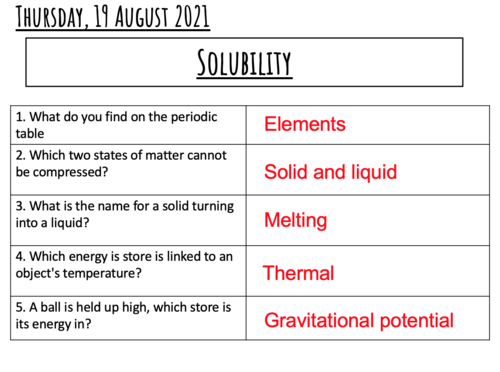
123Uploads
29k+Views
8k+Downloads
Chemistry

C1.2 Separating mixtures
Aimed at a mixed ability year 9 class
starter:
Differentiated starter task from previous learning. Bronze = level 4 silver – level 6 gold = level 8 (to be gaining a level 8 answer needs to be really detailed) students have done this at KS3
Go through and green pen answers
Main
Talk about safety for the practical, demo practical with distillation to get pure water
Students carry out rock salt practical to get salt
Answer questions when done, extension question available also
Plenary
5 mins
Identify the three processes we have learnt about today
Homework - differentiated
Summary sheet on separation techniques

C1.4 fractional distillation and paper chromatography
aimed at a mixed ability year 9 class
Starter Activity
Match key words to definitions – go through answers
Main –
Students watch demo of fractional distillation. Explain uses/whats happening at each point. Students the write an explaination of how they can obtain pure ethanol
Set up chromatography experiment, whilst waiting for it to develop write a step by step method for the practical. Go over basics, this will be revisited as chromatography is a required practical.
Plenary
Tweet one thing they have learnt today

C1.7 Ions, atoms and isotopes
aimed at mixed ability year 9 class
Starter Activity
Differentiated Bronze/silver/gold questions from previous lesson
Main –
Think, pair, share – how big is an atom. Copy down the size of an atom and nucleus intho their books
Copy key words need to be able to define ion and isoptope for level 4
Explain that atoms can lose or gain electrons. And what happens if they do. Students make notes on this, then go through a few examples.
Students practice working out electron/proton/neutron for ions
Extension task for students who finish
Explain what an isotope is, do one worked example of finding proton/neutron numbers then their go at finding how many protons and neutrons are in carbon isotopes
Exam practice if time
Plenary
Identify whether the pictures are atoms, ions or isotopes

C1.1 History of the atom
Aimed at a mixed ability year 9 class
Starter Activity
Draw and label the atom – discuss that its changed over time
Main –
Watch video of history of the atom – try and list the scientists and their discoveries
Use textbooks or ipads to research the history of the atom and fill in the timeline. Differentiated version, blank version for HA students and LA version with question prompts
Extension fill in the gaps sheet
Plenary
Draw the current atom from memory and label it

C1. 8 electronic structures
Aimed at a mixed ability year 9 class
Starter Activity
Exam question starter – go through and green pen
Main –
Recap where to find the number of electrons an atom has, go through electronic structure rules. Do a few examples on the board
Two worksheets – first worksheet students need to find out the number of protons, neutrons and electrons each element has, the second they need to draw the electronic structures
Extension: explain why sodium and lithium might react in a similar way
Write a step by step guide for somebody to explain how you draw electronic structures
Plenary
Exam question plenary – spot mistakes in the electronic structures

Mixtures
Suitable for KS3
Includes
Recall starter
Element mixture or compound particle diagrams and task
Mini demo or practical to show how we can separate mixtures
Written task to explain how properties can help us separate mixture
Peer assessment grid
recall plenary

Pure and Impure
Suitable for KS3
Includes:
Recall starter
Pure and impure including particle diagrams
Pure and impure boiling points
practical investigation to investigate purity

Solubility KS3
Suitable for year 7/8
Recall starter
Followed by explaination and practice of the new keywords solute/solvent/solution
Questions and tasks provided with answers
mini practical to do with solubility, does it dissolve or not?
Questions for follow up to the practical
Recall plenary

C3 Quantitative chemistry tutoring
A tutoring powerpoint I used does not include percentage yield.
Comes with a key question document and exam questions.
All answers to powerpoint included as animations or in the notes below

KS3 investigating solubility
Lesson includes a practical to investigate how temperature affects solubility.
Comes with an optional work sheet.











